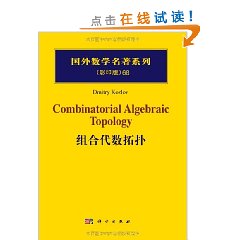內容簡介
《組合代數拓撲(影印版)》內容簡介:Combinatorialalgebraictopologyisafascinatingand
 組合代數拓撲
組合代數拓撲dynamicfieldatthecrossroadsofalgebraictopologyanddiscretemathematics.Thisvolumeisthefirstcomprehensivetreatmentofthesubjectinbookform.Thefirstpartofthebookconstitutesaswftwalkthroughthemaintoolsofalgebraictopology,includingStiefel-Whitneycharacteristicclasses,whichareneededforthelater.parts.Readers-graduatestudentsandworkingmathematiciansalike-willprobablyfindparticularlyusefulthesecondpart,whichcontainsanin-depthdiscussionofthemajorresearchtechniquesofcombinatorialalgebraictopology.Ourpresentationofstandardtopicsisquitedifferentfromthatofexistingtexts.Inaddition,severalnewthemes,suchasspectralsequences,areincluded.Althoughapplicationsaresprinkledthroughoutthesecondpart,theyareprincipalfocusofthethirdpart,whichisentirelydevotedtodevelopingthetopologicalstructuretheoryforgraphhomomorphisms.Themainbenefitforthereaderwillbetheprospectoffairlyquicklygettingtotheforefrontofmodemresearchinthisactivefield.
作者簡介
作者:(德國)科茲洛夫(DmitryKozlov)
目錄
1 Overture
Part Ⅰ Concepts of Algebraic Topology
2 Cell Complexes
2.1 Abstract Simplicial Complexes
2.1.1 Definition of Abstract Simplicial Complexes and Maps Between Them
2.1.2 Deletion,Link,Star,and Wedge
2.1.3 Simplicial Join
2.1.4 Face Posets
2.1.5 Barycentric and Stellar Subdivisions
2.1.6 Pulling and Pushing Simplicial Structures
2.2 Polyhedral Complexes
2.2.1 Geometry of Abstract Simplicial Complexes
2.2.2 Geometric Meaning of the Combinatorial Constructions
2.2.3 Geometric Simplicial Complexes
2.2.4 Complexes Whose Cells Belong to a Specified Set of Polyhedra
2.3 Trisps
2.3.1 Construction Using the Gluing Data
2.3.2 Constructions Involving Trisps
2.4 CW Complexes
2.4.1 Gluing Along a Map
2.4.2 Constructive and Intrinsic Definitions
2.4.3 Properties and Examples
3 Homology Groups
3.1 Betti Numbers of Finite Abstract Simplicial Complexes
3.2 Simplicial Homology Groups
X Contents
3.2.1 Homology Groups of Trisps with Coefficients in Z2
3.2.2 Orientations
3.2.3 Homology Groups of Trisps with Integer Coefficients
3.3 Invariants Connected to Homology Groups
3.3.1 Betti Numbers andTORSIONCoefficients
3.3.2 Euler Characteristic and the Euler-Poincar6 Fc'rmula
3.4 Variations
3.4.1 Augmentation and Reduced Homology Groups
3.4.2 Homology Groups with Other Coefficients
3.4.3 Simplicial Cohomology Groups
3.4.4 Singular Homology
3.5 Chain Complexes
3.5.1 Definition and Homology of Chain Complexes
3.5.2 Maps Between Chain Complexes and Induced Mapson Homology
3.5.3 Chain Homotopy
3.5.4 Simplicial Homology and Cohomology in the Contextof Chain Complexes
3.5.5 Homomorphisms on Homology Induced by Trisp Maps
3.6 Cellular Homology
3.6.1 An Application of Homology with Integer Coefficients:Winding Number
3.6.2 The Definition of Cellular Homology
3.6.3 Cellular Maps and Properties of Cellular Homology
4 Concepts of Category Theory
4.1 The Notion of a Category
4.1.1 Definition of a Category.Isomorphisms
4.1.2 Examples of Categories
4.2 Some Structure Theory of Categories
4.2.1 Initial and Terminal Objects
4.2.2 Products and Coproducts
4.3 Functors
4.3.1 The Category Cat
4.3.2 Homology and Cohomology Viewed as Functors
4.3.3 Group Actions as Functors
4.4 Limit C0nstructions
4.4.1 Definition of Colimit of a Functor
4.4.2 Colimits and Infinite Unions
4.4.3 Quotients of Group Actions as Colimits
4.4.4 Limits
4.5commaCategories
4.5.1 Objects Below and Above Other Objects
4.5.2 The General Construction and Further Examples
……
Part Ⅱ Methods of Combinatorial Algebraic Topology
Part Ⅲ Complexes of Graph Homomorphisms
References
Index
